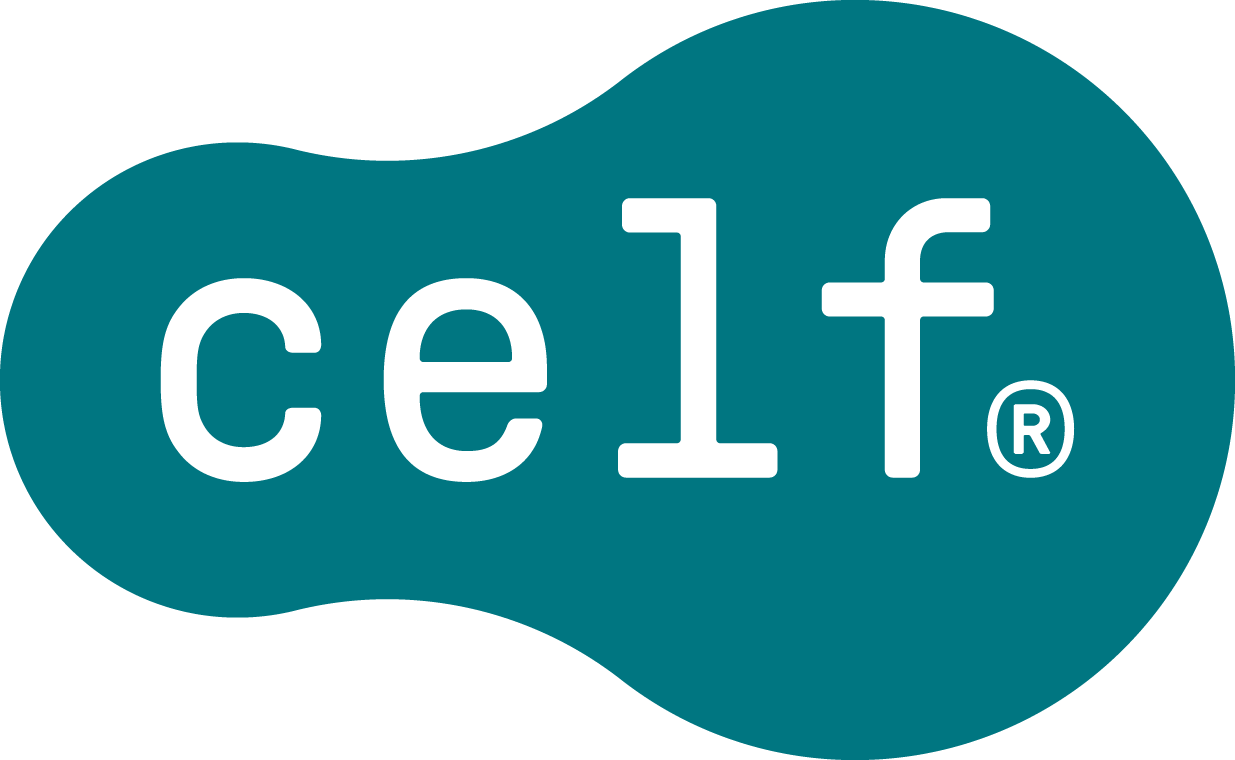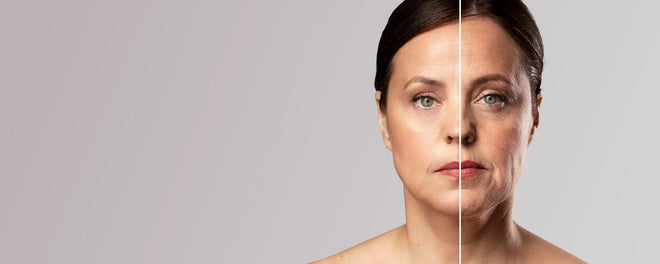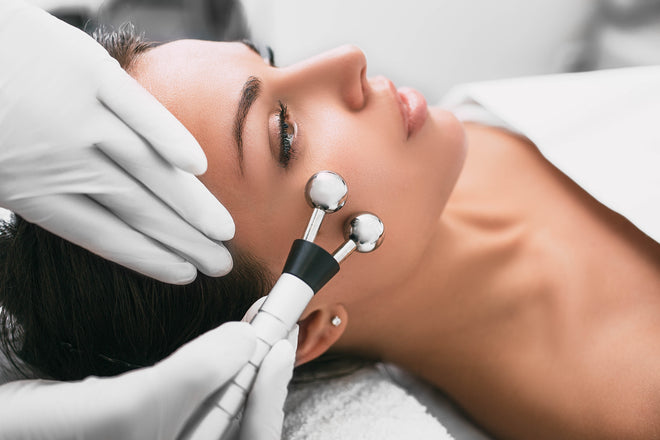How to Boost Skin Elasticity Naturally: Collagen, Elastin & Lifestyle Tips
Table of Contents
Boost Skin Elasticity: Collagen, Elastin & Lifestyle Tips
I. Why Skin Elasticity Matters
Skin elasticity is a vital health and youthfulness marker of skin. It signifies the ability of skin to return to normal shape after being stretched out or compressed. Skin elasticity shows resilience—this is what gives your face its lifted nature, your neck its suppleness and your overall skin its firm appearance.
Skin elasticity does not last forever, and over time with healthy aging skin we slow down the production of structural proteins (most importantly, collagen and elastin). It's also well-documented that external aggressors like UV rays, air pollution and chronic stress all further decrease the production of collagen and elastin.
When elasticity declines, we start to experience fine lines, saggy skin, skin dullness, and uneven skin texture. The good news is that science has proven these changes are not permanent. By supporting the body’s natural production of collagen and elastin, and avoiding some of the external damage, you really can see a noticeable improvement to your skin’s firmness and elasticity.
The underlying principle is exactly what CELF Microvibration Therapy was designed for. By delivering gentle, low-frequency vibrations, CELF engages fibroblast cells deep in the dermis. These cells are responsible for collagen production, and the activation of these cells can help to restore your skin's structural integrity.
II. Collagen: The Glue that Holds Your Skin Together
Collagen is often called the "glue" that holds your skin together. It provides form, firmness, and support. There are 28 collagens in the human body, but the key 2 collagens in skin are Type I and Type III. Type I provides tensile strength, and Type III provides the skin with flexibility and softness. The two work together forming a dense, fibrous network in the dermis tissue that keeps skin plump and youthful.
Sadly, collagen production declines with age. In your mid-20s, your body starts to produce reduced collagen levels annually. By your 40s, collagen synthesis greatly reduces to about 30%-50% of what it was. This decrease is often complicated by hormonal changes and environmental insults. UV rays and chronic inflammation can degrade the levels of existing collagen as well, weakening the skin even more.
Collagen supplements are all the rage. But the research is still unclear. As per Harvard Health, topical and ingested collagen may not have much benefit if it is not paired with lifestyle changes and topical stimulators.
What works the best?
Work on stimulating fibroblasts with proven actives from skincare like Vitamin C, peptides and retinoids, and also provide a mechanism of action to produce collagen.
CELF Microvibration Therapy does just this. By gently stimulating the fibroblasts, you are able to restart the stimulation of collagen production from the inside out.
III. Elastin: The Secret to the Bounce in Your Skin
While collagen is discussed in the mainstream, elastin is equally signifdicant for maintaining healthy skin.Elastin is the protein responsible for elasticity/stretch in the skin. This elasticity allows the skin to bounce back (i.e.) after movement like smiling or frowning. Collagen lends structure to the skin, elastin lends flexibility which retains its shape/prevents sagging or loss of tone.
Unlike collagen, elastin is produced in our bodies in very limited capacity after we grow up. This makes elastic tissue damage much more difficult to repair which is why it is important to act to protect and preserve what elastin we do have in our skin from damage.
Chronic sun exposure is the primary offender: The UV rays penetrate the skin creating damage in the dermis and elastin fibers are degraded over time in a chemical reaction defined as solar elastosis. A study by the National Institute of Health Library found that repeated UV exposure results in irreversible elastin degradation.
How can you maintain and preserve elastin?
-
Use broad-spectrum SPF daily
-
Use antioxidants like Vitamin C and Vitamin E to offset oxidative damage to elastin
-
Avoid smoking or exposure to environmental pollutants
CELF has a unique advantage.
Rather than just sit on the surface of skin like traditional elastin creams, CELF penetrates deeper skin layers with low-frequency microvibration – stimulating fibroblast activity in elastin-rich regions, stimulating bounce and resilience in the skin for the long term.
IV. Lifestyle Changes to Support Skin Elasticity
A) Nutrition - feed your skin from the inside out
What we consume has a direct influence on our skin's elasticity. Collagen and elastin proteins are made from amino acids, and the body needs dietary sources to make these proteins – especially glycine, proline, and lysine. These amino acids that support skin elasticity in collagen and elastin proteins can be found abundantly in bone broth, fish, eggs, leafy greens, and legumes; surrounding major foods to consider adding to your routine in order to feed your skin.
Other nutrients referred to are essential in cross-linking collagen and elastin are Vitamin C, Zinc, Copper and Sulfur.
The inflammatory foods, specifically sugar, processed carbohydrates, and trans fat, contribute to glycation that occurs when sugar binds to protein, weakening the effective function of collagen and elastin proteins. When the skin experiences glycation it occurs causing the collagen and elastin to stiffen, resulting in dull and sagging skin.
A study published in Dermato-Endocrinology shows that nutrient-rich eating not only slows the skin aging process but promotes skin regeneration. Foods rich in antioxidants, such as berries, citrus fruits, green tea and dark chocolate, fight oxidative-stress within the body and help protect the elastin damage caused by UV rays.
Insider tip:
Combine nutrient-rich eating with topical products that are good carriers, thereby promoting the absorption of nutrients that you supply transdermally.
CELF’s microvibration technology enhances penetration to the full depth of the epidermis, thus allowing you to get the most benefit from any serums or nutrients you apply.
B) Hydration & Hyaluronic Acid: Plumpness Starts There!
What do we mean when we say that skin is “elastic?”
Elasticity is a direct result of skin hydration. Happy, hydrated skin cells remain plump and functional; thus, maintaining structure, and preventing fine lines from forming.
Within this structural hydration matrix, hyaluronic acid (HA) is a superstar humectant molecule that holds 1000 times its weight in water!
Natural HA levels decrease as we age, meaning skin has less capability to retain moisture. There are topical HA serums on the market—but they only work if they get absorbed and utilized. That is what CELF can provide—in a measurable way.
CELF Microvibration Therapy improves micro-circulation and removes dead skin cells, pre-conditioning your skin to absorb serums deeper.
When applied after cleansing with CELF serums, HA serums can penetrate deeper into the dermis, towards more intense layers of hydration, helping to replenish moisture and elasticity from within.
Remember to drink water to hydrate internally too – you should drink around 2 to 3 litres of water a day, and eat/wash foods that have a high water volume or content like cucumbers, watermelon and celery.
When it comes to skin laxity, hydration and internal hydration is your first line of defence. With CELF, not only will your skin balance the hydration of moisture, but it will also optimize the moisture ratio into your viable epidermis.
C) Sleep, Stress & Hormonal Balance
When you are asleep your body heals, including your skin. Deep restorative sleep, even for a couple of hours a night, triggers the production of growth hormone, which triggers cellular regeneration, collagen production, and repair to the skin barrier.
On the other hand, sleep deprivation increases cortisol in your body and speeds up the degradation of collagen and elastin in your skin.
Cortisol can also throw hormones out of balance and affect hormone levels of estrogen and DHEA; both of which are essential when considering skin thickness and elasticity, particularly in women.
For example, there is a very clear and tangible connection between pain and skin. Therefore, even minor changes (too much cortisol) over the course of a few days will show in your skin as dull, inflamed, or textured.
In order to keep your elasticity intact, you must develop sleep hygiene and stress resiliency:
-
Sleep 7–9 hours overnight
-
Avoid blue light after sundown
-
Include adaptogens such as ashwagandha
-
Practice moderate movement and mindfulness (such as meditation)
CELF matches these rhythms.
Used in your evening routine, CELF increases blood flow, offers relaxation, decompresses facial tension, and encourages the skin to repair more effectively while you sleep.
Rest and recover, and recharge—with a little help from CELF. See how we can include CELF in your nightly ritual →
D. Sun Protection & Environmental Defense
Sun damage is the number one cause of premature loss of skin elasticity. UVA not only penetrates the epidermis; when UVA reaches the dermis, it damages collagen and elastin through free-radical generation and enzymatic activity. This is called photoaging, and it is cumulative over time.
In addition to UV, blue light from screens, in addition to ambient pollution, can lead to oxidative stress, further compromising the skin's moisture barrier and irritating sagging.
This is why cognitive daily broad-spectrum sunscreen is essential, even if you are inside. Look for SPFs that also offer infrared and blue light protection, depending on your overall environmental exposure, and use with an antioxidant serum containing Vitamin E, Niacinamide, or Ferulic Acid.
Don't just protect—also repair, and rebuild with CELF.
V. Cutting Edge Skincare Technologies: CELF Microvibration
The science of skincare is evolving faster than ever. After all, topical creams and serums can only restore so much elasticity. To truly reverse the loss of firmness and bounce, we need to activate change below the surface of the skin. That's what CELF Microvibration Therapy is designed to do.
CELF applies the validated science of low-frequency sonic microvibrations to fibroblasts (the dermal cells that produce collagen and elastin) and gently agitates them. When fibroblasts are activated and agitated, they begin to "act younger", releasing more of the structural proteins that your skin needs to stay firm, elastic, and lifted.
This technology is powered by the Oral B iO Series 8, repurposed and clinically evaluated by dermatologists for mechanical stimulation.
CELF microvibrations obviously stand alone, but the effects can be supercharged when used with topical skincare. When it is applied along with topical antioxidant serums or hydrating actives (like hyaluronic acid), the microvibrations deliver up to 3x improved delivery of topical actives products.
Skin care shouldn't be complicated—it should be smart. With CELF, you get dermatologist-level outcomes in just 2 minutes per day.
VI. FAQ: Your Skin Elasticity Questions
Q1: When does skin lose elasticity?
Skin elasticity starts to decline in your mid to late 20s, with a noticeable decline starting in your 30s, even more noticeable by your 40s. This is a natural process. Production of collagen and elastin slows down as we age, but lifestyle factors such as sun damage, stress, and nutrition are cumulative and can exacerbate the aging process.
Q2: Can you really restore skin elasticity?
Yes—you cannot turn back time, but you can stimulate your skin to behave in a more youthful manner. You need to stimulate fibroblast activity, protect existing collagen, and create new structural proteins. These are the exact outcomes from CELF Microvibration Therapy.
Q3: What is the difference between CELF and a facial massage tool?
Most tools are inherently based on superficial friction, or vibration. CELF is based on calibrated microvibrations, using the Oral B iO, which are scientifically calibrated to target the dermal layer, where structural change can occur. This is not a facial massage: it is mechanical stimulation based on dermatologic science.
Q4: Can I use CELF with my skincare regimen?
Yes! CELF actually adds value to your skincare regimen by improving circulation and absorption of your serums. Use it after cleansing the skin and before moisturizing for best performance.
Still have questions? Check out our Help Center →
VIII. Conclusion: Your Skin Elasticity Action Plan
Restoring skin elasticity is not about a quick fix; rather, it is about how your skin works and supporting it in restoring itself. With the right knowledge and a bit of science-based support, you can turn back the clock on sagging skin and regain the bounce you enjoyed before.
Here is your action plan:
-
Collagen and Elastin are the scaffolding for tight, youthful-looking skin. You must continuously stimulate fibroblasts.
-
Lifestyles matter: Feed your skin with protein, hydrate enough, manage stress, wear sunscreen.
-
Product penetration matters: Your products will not help if they do not penetrate, and that will be supported by CELF.
-
Use CELF two minutes a day to see evidence of improvement in elasticity, tone, and texture.
Consistency is key - and that's where CELF comes in. With expertly designed microvibration, we make turning 2 minutes a day into a lifetime of skin resilience simple.
Whether you're 28 or 58 - there is never a bad time to regain the bounce in your skin.
Are you ready to go deeper with your skincare?
Let's get started with CELF →
FAQs
1. How can I increase collagen and elastin in my skin?
To boost collagen and elastin, combine a healthy diet rich in vitamin C, zinc, and amino acids with habits like regular exercise, hydration, and sun protection. Topical retinoids, peptides, and treatments like microneedling or red light therapy can also stimulate their natural production.
2. Can you rebuild skin elasticity?
Yes, skin elasticity can be improved over time. While aging naturally reduces elasticity, consistent use of products with retinol, hyaluronic acid, and vitamin C—alongside collagen-stimulating treatments—can help restore firmness and reduce sagging.
3. What vitamin is best for skin elasticity?
Vitamin C is the best vitamin for skin elasticity, as it plays a crucial role in collagen synthesis. It helps protect against free radicals and supports skin firmness. Vitamin E and A (retinol) also aid in maintaining skin structure.
4. What is the #1 nutrient to boost your collagen?
Collagen-boosting peptides (amino acids)—especially glycine, proline, and hydroxyproline—are the #1 nutrients to enhance your body’s natural collagen production. You can get them through bone broth, collagen supplements, or protein-rich foods like eggs and fish.




